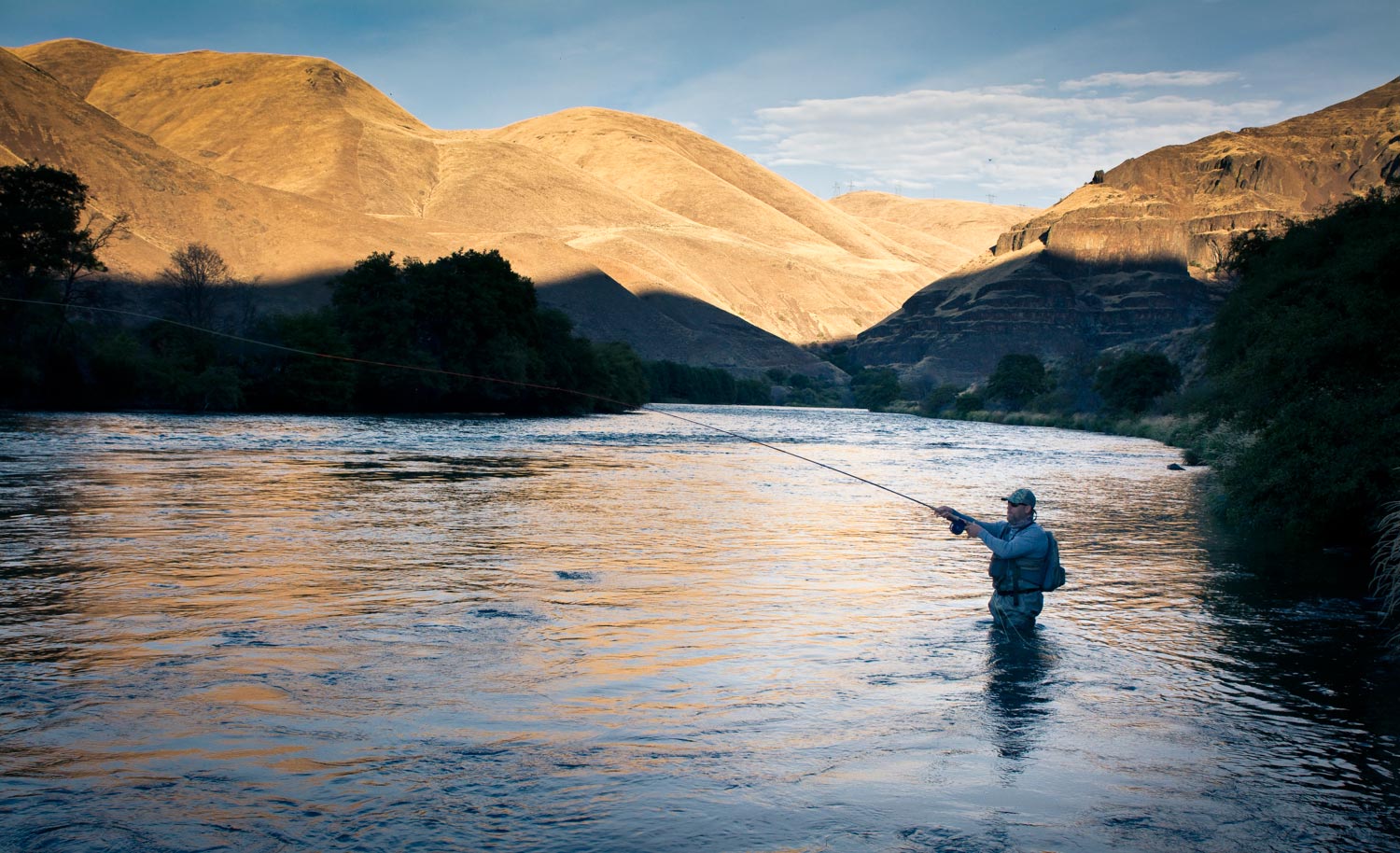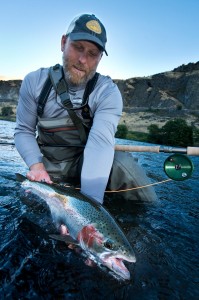By Louis Cahill
Is your fly fishing for the entire swing?
Many anglers who successfully swing flies for steelhead could be catching even more fish by improving their swing. Steelheading is all about taking advantage of every opportunity and it’s pretty common for anglers to waste as much as half their fishing time with a poorly swung fly. I include myself among them. It’s technical business and requires constant attention.
The key to a good swing is keeping the fly moving at just the right speed and angle. That buttery slow swing that gives the fish time to see the fly and react. The gentle motion that entices the attack. It’s a hard thing to visualize and even harder to describe. Fortunately there’s a reliable visual cue that will help you determine when you fly is swinging well and when it isn’t. The belly of your line.
Before we talk about what the belly of the line tells you, let get some terms straight.
The belly is the part of the line which is swept by the current causing an arch in the path of the line. When swinging flies the belly determines the speed at which the fly moves across the current.
Picture yourself fishing from river left. You cast directly across a swift current, which flows from your left to right. Your line bellies down stream so that the middle of your line is down stream of your fly. We will call this a convex belly.
Now, picture yourself on the same side of the river but casting across a slow moving current with your fly landing in faster current on the far side. Your fly moves down stream and hangs below your line, which curves to follow. We will call this a concave belly.
Picture a swing where your line makes the shape of an L. Your fly and leader point in a direction perpendicular to your rod. We will call this a 90% belly. A 45% belly would have less curve in the line and a 100% belly would have more. A straight line swing or 0% belly would have no curve in the line.
When the fly is swinging at a good pace and angle, we will say it’s fishing. Not fishing means the speed and angle are wrong.
Now that we have our terms, what’s the swing we are looking for?
For starters, a concave belly isn’t a good thing. When the line curves out and down, rather than down and across, the fly moves too slowly and the angle presents only the tail of the fly to the fish. This is not to say that a steelhead will never eat a fly swung in this way. It’s happened to me. Fish do crazy things, but it’s not your best presentation.
A good swing presents a convex belly of 90% or less. Any more than 90% and you’re not fishing. The closer you are to a straight line or 0% swing the better your chances of getting a fish.
A belly that looks like a J with the line pointing up stream does not fish. The fly is ripped through the water so fast the fish will not waste the energy chasing it.
My buddy Jeff Hickman explains this well.
“If your line is pointing up stream, you’re not in the game. If it’s pointing across the current, it’s a lottery. The further downstream it’s pointing, the better the odds.”
The lost zones
Most folks get a swing that fishes at some point during its progress across the river. Usually through the middle of the swing. The parts of the swing where the most trouble occurs are at the beginning and the end of the swing. I call these the lost zones. If you are catching all of your steelhead in the middle of your swing, this may be why. There are a couple of things you can do to help.
It starts with a good cast.
A good Spey cast delivers a nice tight loop which allows the entire system, fly, leader, head and running line to land on the water at the same time. When this happens, the swing is instantly under the angler’s control. A common problem is for the head to land on the water before the leader, fly and sink tip if you’re fishing skagit style. When this happens, the current takes the line downstream before the fly even lands. The J belly of over 90% is already in place when the angler gains control of the line.
The most common cause for this casting malfunction is wood chopper’s syndrome. That’s when the caster’s top hand moves forward during the casting stroke, creating a downward arch in the line. Remember, the casting stroke is powered by the bottom hand.
And then a good mend
In most cases, even when you’ve made a great cast, it still needs to be followed up by a good mend. A good mend is one where the entire head is realigned. If you’ve made a good cast and a good mend, your fly should be the part of the system which is farthest down stream.
Then you slow it down
The first part of the swing is always the most challenging. Your line is usually crossing swift current and the tendency is for the fly to move too quickly across the river. To slow the fly down, keep the tip of your rod held high and pointed straight across the current. As the fly swings down stream, lower the rod tip and draw the rod closer to your body then slowly start to turn it down stream. This will keep the fly moving at a slow and tempting pace in the fast water.
Leading it in
The end of the swing is another matter. There are a lot of steelhead to be caught on the hang down. The problem is that too many anglers never get the fly to them. A fly takes a surprisingly long time to reach the very end of the swing and it needs some help getting there.
Lead the fly into the soft water by pointing your rod tip toward the bank and touching it to the water. Be patient. It takes longer than you might think for it to make the journey. The best way to get a feel for it is to swing dry flies. When you see the dry fly on its course, you realize how aggressively you must lead the fly in and how long it takes.
Next time you’re swinging flies, pay close attention to the belly of your line. It will tell you a lot about whether or not your fly is actually fishing. Try a few of these techniques and see if you don’t catch more steelhead.
Louis Cahill Gink & Gasoline www.ginkandgasoline.com hookups@ginkandgasoline.com Sign Up For Our Weekly Newsletter!


If you fish from river left does not the current flow from your right to left?
Thanks Louis! A couple of simple illustrations would make it easier to communicate the good/better/best swing angles and bellies.